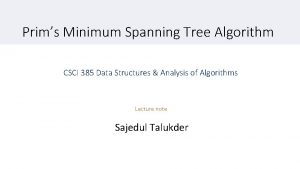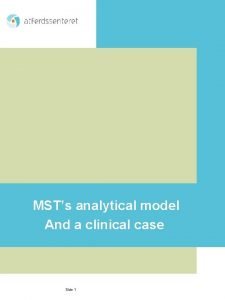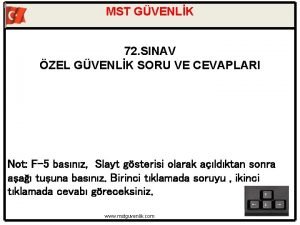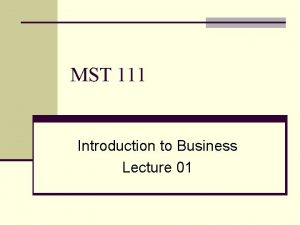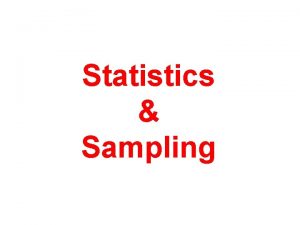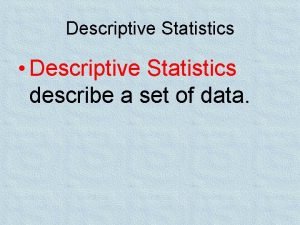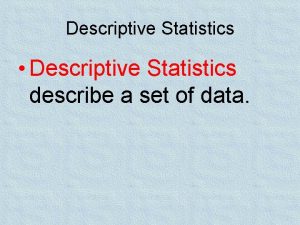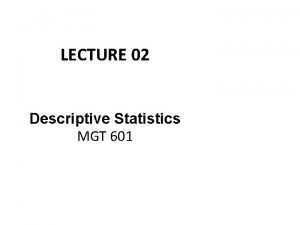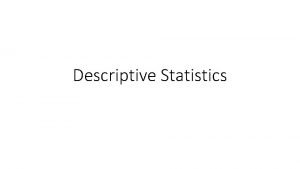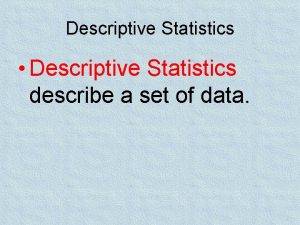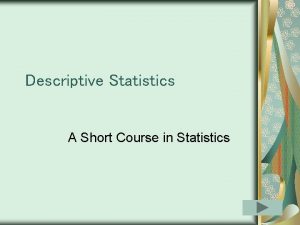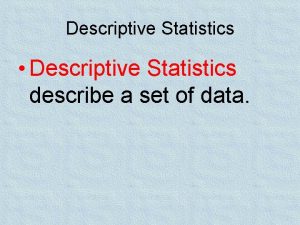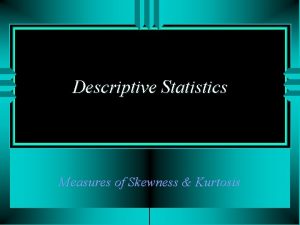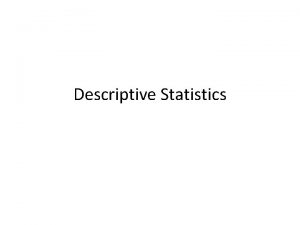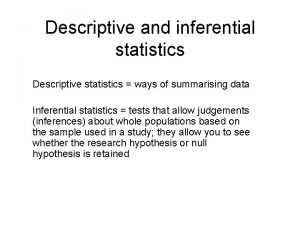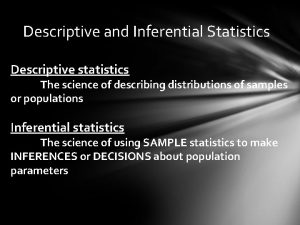MST 101 Descriptive Statistics Descriptive Statistics l Purpose
























- Slides: 24

MST 101 Descriptive Statistics

Descriptive Statistics l Purpose – to describe or summarize data in a parsimonious manner l Four types ¡ Central tendency ¡ Variability ¡ Relative position ¡ Relationships

Descriptive Statistics l Graphing data – a frequency polygon ¡ ¡ Vertical axis represents the frequency with which a score occurs Horizontal axis represents the scores themselves

Central Tendency l Purpose – to represent the typical score attained by subjects l Three common measures ¡ Mode ¡ Median ¡ Mean

Central Tendency l Mode ¡ ¡ l The most frequently occurring score Appropriate for nominal data Median ¡ ¡ The score above and below which 50% of all scores lie (i. e. , the mid-point) Characteristics l l Appropriate for ordinal scales Doesn’t take into account the value of each and every score in the data

Central Tendency l Mean ¡ The arithmetic average of all scores ¡ Characteristics Advantageous statistical properties l Affected by outlying scores l Most frequently used measure of central tendency l ¡ Formula

Variability l Purpose – to measure the extent to which scores are spread apart l Four measures ¡ Range ¡ Quartile deviation ¡ Variance ¡ Standard deviation

Variability l Range ¡ The difference between the highest and lowest score in a data set ¡ Characteristics Unstable measure of variability l Rough, quick estimate l

Variability l Quartile deviation ¡ One-half the difference between the upper and lower quartiles in a distribution ¡ Characteristic - appropriate when the median is being used

Variability l Standard deviation ¡ The square root of the variance ¡ Characteristics Many important statistical properties l Relationship to properties of the normal curve l Easily interpreted l ¡ Formula

The Normal Curve l. A bell shaped curve reflecting the distribution of many variables of interest to educators

The Normal Curve l Characteristics ¡ ¡ Fifty-percent of the scores fall above the mean and fiftypercent fall below the mean The mean, median, and mode are the same values Most participants score near the mean; the further a score is from the mean the fewer the number of participants who attained that score Specific numbers or percentages of scores fall between +/-1 SD, +/-2 SD, etc.

The Normal Curve l Properties ¡ Proportions under the curve +/-1 SD 68% l +/-2 SD 95% l +/-3 SD 99% l ¡ Cumulative proportions and percentiles SD = Standard Deviation

Skewed Distributions Positive – many low scores and few high scores l Negative – few low scores and many high scores l Relationships between the mean, median, and mode l ¡ ¡ Positively skewed – mode is lowest, median is in the middle, and mean is highest Negatively skewed – mean is lowest, median is in the middle, and mode is highest

Measures of Relative Position l Purpose – indicates where a score is in relation to all other scores in the distribution l Characteristics ¡ Clear estimates of relative positions ¡ Possible to compare students’ performances across two or more different tests provided the scores are based on the same group

Measures of Relative Position l Z-score ¡ ¡ ¡ The deviation of a score from the mean in standard deviation units The basic standard score from which all other standard scores are calculated Characteristics l l Mean = 0 Standard deviation = 1 Positive if the score is above the mean and negative if it is below the mean Relationship with the area under the normal curve

Measures of Relative Position l Z-score (continued) ¡ Possible to calculate relative standings like the percent better than a score, the percent falling between two scores, the percent falling between the mean and a score, etc. ¡ Formula

Measures of Relative Position l T-score – a transformation of a z-score where t = 10(Z) + 50 ¡ Characteristics Mean = 50 l Standard deviation = 10 l No negative scores l

Measures of Relationship Purpose – to provide an indication of the relationship between two variables l Characteristics of correlation coefficients l ¡ ¡ l Strength or magnitude – 0 to 1 Direction – positive (+) or negative (-) Types of correlations coefficients – dependent on the scales of measurement of the variables ¡ ¡ Spearman Rho – ranked data Pearson r – interval or ratio data


Formula for the Mean

Formula for Standard Deviation

Formula for Pearson Correlation

Formula for Z-Score
 Physics 2135 mst
Physics 2135 mst Mst tu delft
Mst tu delft Mst trace
Mst trace Mst powerpoint template
Mst powerpoint template Mst prim algorithm pseudocode
Mst prim algorithm pseudocode Physics 1135 mst
Physics 1135 mst Projectile apparatus with impact board and launching ramp
Projectile apparatus with impact board and launching ramp Physics 1135
Physics 1135 Mst 9 principles
Mst 9 principles Mst analytical process
Mst analytical process Mst analytical process
Mst analytical process Prim algorithm pseudo code
Prim algorithm pseudo code Rochelle mantanona
Rochelle mantanona Mst cont
Mst cont Prims algorithm pseudocode
Prims algorithm pseudocode What is mst
What is mst Bellman's algorithm destiny 2
Bellman's algorithm destiny 2 Escala mst
Escala mst Alchohol
Alchohol Mst mechanical engineering
Mst mechanical engineering Mst
Mst Tamirul millat mohila kamil madrasah
Tamirul millat mohila kamil madrasah Physics 2135
Physics 2135 Toplu tabancalarda tırnak nerededir
Toplu tabancalarda tırnak nerededir Mst 111
Mst 111




